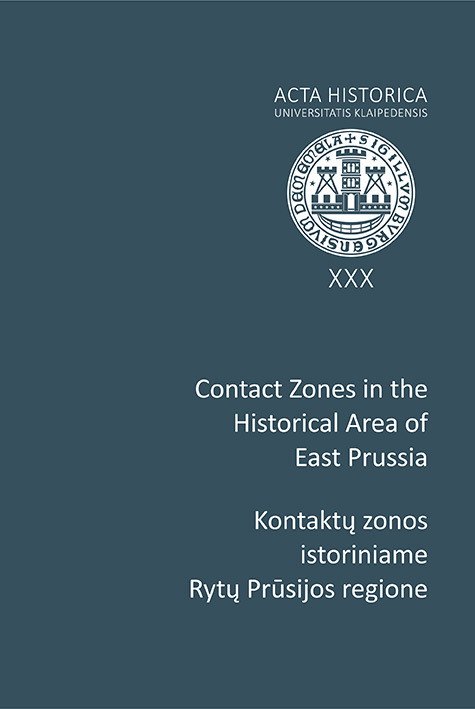Volume 30 (2015): Contact Zones in the Historical Area of East Prussia = Kontaktų zonos istoriniame Rytų Prūsijos regione, December 2015

Order by:
Pub. online: 2 Dec 2015
Type: Editorial Note
 Open Access
Open Access
Journal:
Acta Historica Universitatis Klaipedensis
Volume 30 (2015): Contact Zones in the Historical Area of East Prussia = Kontaktų zonos istoriniame Rytų Prūsijos regione, p. 5
Pub. online: 2 Dec 2015
Type: Introduction
 Open Access
Open Access
Journal:
Acta Historica Universitatis Klaipedensis
Volume 30 (2015): Contact Zones in the Historical Area of East Prussia = Kontaktų zonos istoriniame Rytų Prūsijos regione, pp. 6–12
Pub. online: 2 Dec 2015
Type: Introduction
 Open Access
Open Access
Journal:
Acta Historica Universitatis Klaipedensis
Volume 30 (2015): Contact Zones in the Historical Area of East Prussia = Kontaktų zonos istoriniame Rytų Prūsijos regione, pp. 13–19
Pub. online: 2 Dec 2015
Type: Article
 Open Access
Open Access
Journal:
Acta Historica Universitatis Klaipedensis
Volume 30 (2015): Contact Zones in the Historical Area of East Prussia = Kontaktų zonos istoriniame Rytų Prūsijos regione, pp. 20–38
Abstract
Pub. online: 2 Dec 2015
Type: Article
 Open Access
Open Access
Journal:
Acta Historica Universitatis Klaipedensis
Volume 30 (2015): Contact Zones in the Historical Area of East Prussia = Kontaktų zonos istoriniame Rytų Prūsijos regione, pp. 39–73
Abstract
Pub. online: 2 Dec 2015
Type: Article
 Open Access
Open Access
Journal:
Acta Historica Universitatis Klaipedensis
Volume 30 (2015): Contact Zones in the Historical Area of East Prussia = Kontaktų zonos istoriniame Rytų Prūsijos regione, pp. 74–83
Abstract
Pub. online: 2 Dec 2015
Type: Article
 Open Access
Open Access
Journal:
Acta Historica Universitatis Klaipedensis
Volume 30 (2015): Contact Zones in the Historical Area of East Prussia = Kontaktų zonos istoriniame Rytų Prūsijos regione, pp. 84–100
Abstract
Pub. online: 2 Dec 2015
Type: Article
 Open Access
Open Access
Journal:
Acta Historica Universitatis Klaipedensis
Volume 30 (2015): Contact Zones in the Historical Area of East Prussia = Kontaktų zonos istoriniame Rytų Prūsijos regione, pp. 101–125
Abstract
Pub. online: 2 Dec 2015
Type: Article
 Open Access
Open Access
Journal:
Acta Historica Universitatis Klaipedensis
Volume 30 (2015): Contact Zones in the Historical Area of East Prussia = Kontaktų zonos istoriniame Rytų Prūsijos regione, pp. 126–145
Abstract
Pub. online: 2 Dec 2015
Type: Article
 Open Access
Open Access
Journal:
Acta Historica Universitatis Klaipedensis
Volume 30 (2015): Contact Zones in the Historical Area of East Prussia = Kontaktų zonos istoriniame Rytų Prūsijos regione, pp. 146–169
Abstract